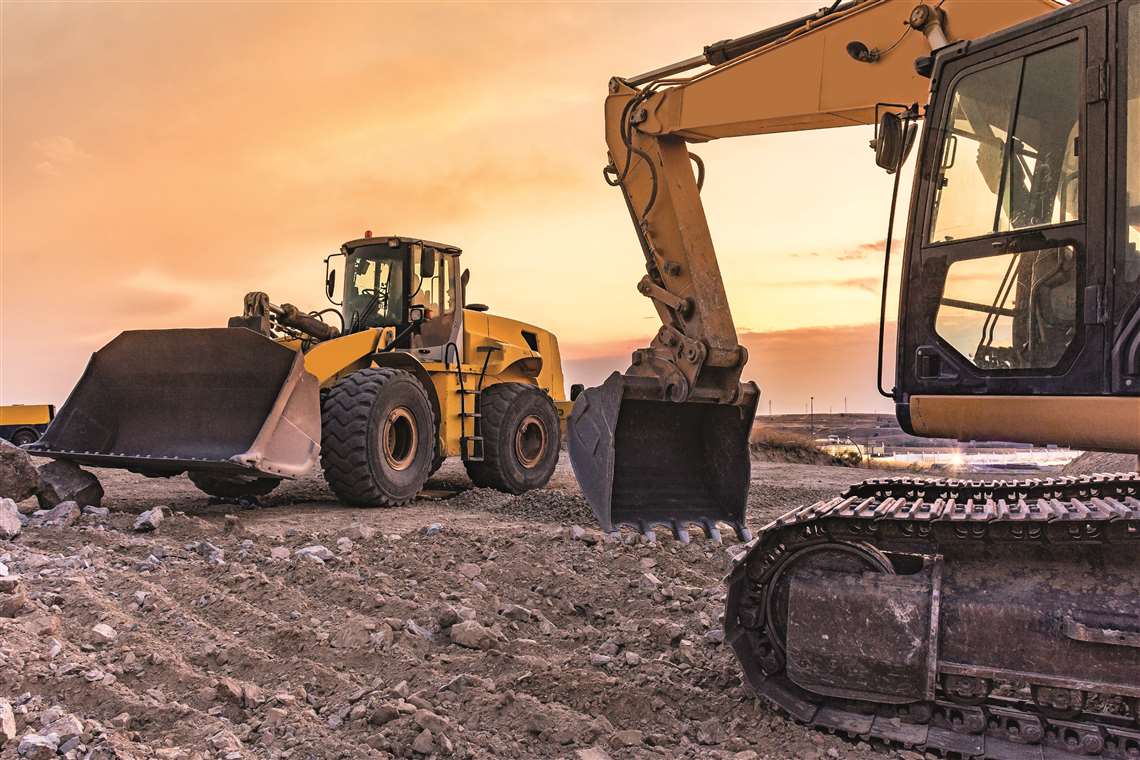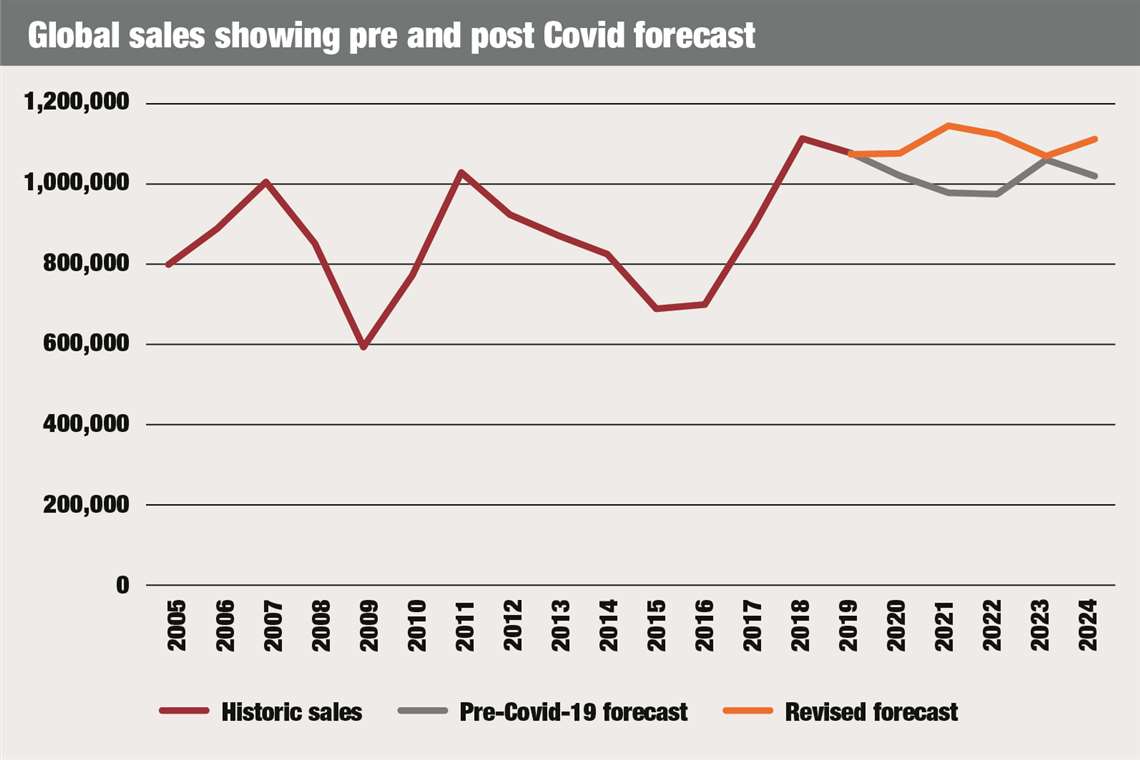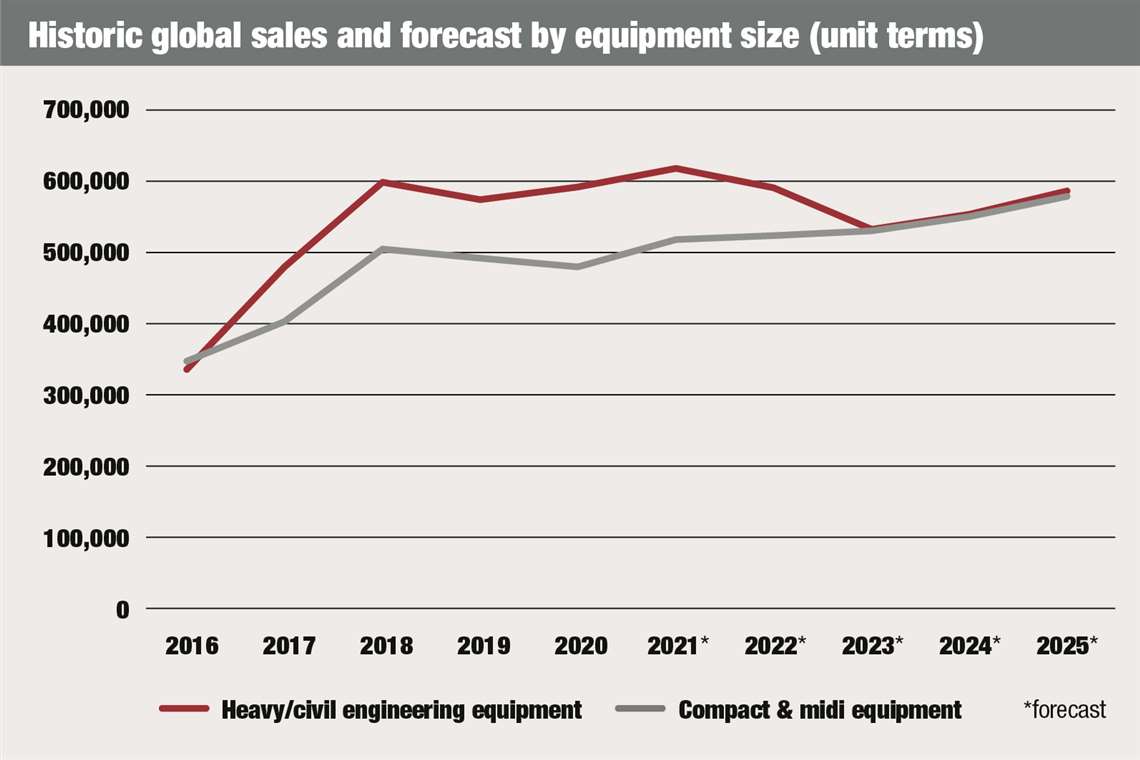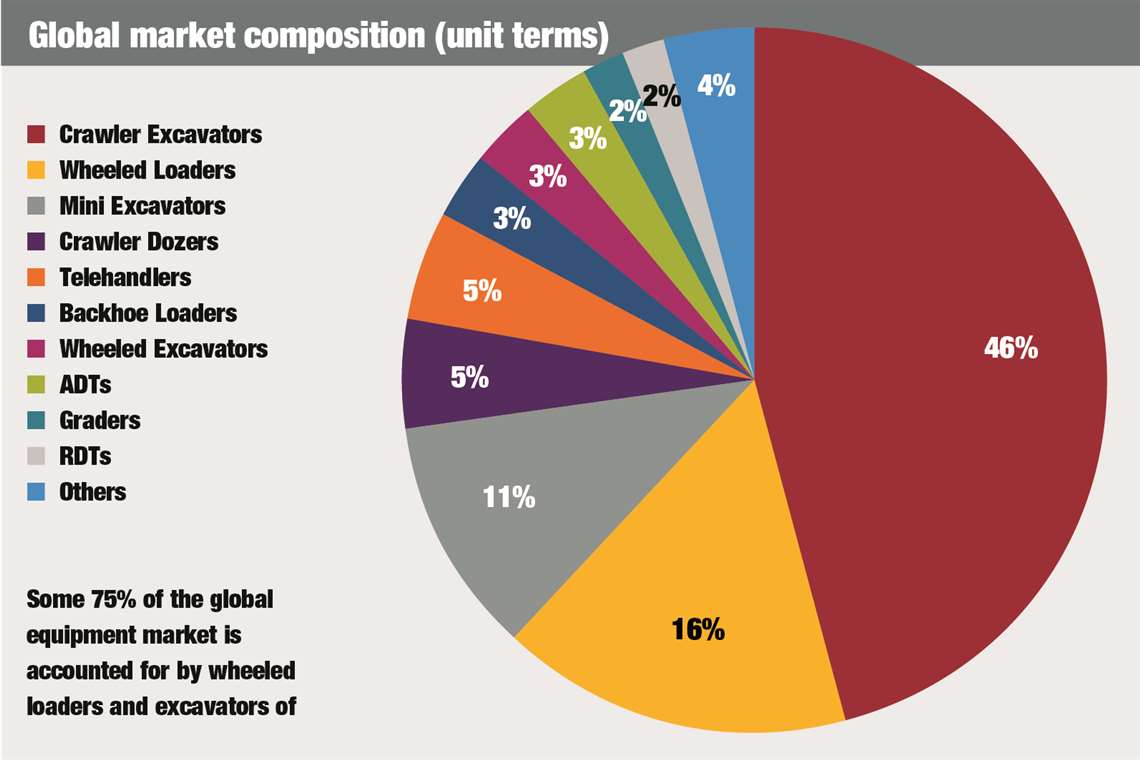What was Covid’s impact on construction equipment sales?
11 June 2021
What impact did the Covid pandemic have on the global construction equipment market in 2020 and what does it mean for the future?

After a period of weakness in the early and mid-part of the 2010s, global equipment sales picked up at the end of 2016.
Robust growth followed in 2017 and 2018, taking the global market to a record high of 1.1 million units sold in 2018. This level was more or less maintained in 2019, but the markets began to soften towards the end of the year.
Construction equipment is a cyclical business; it was anticipated that 2020 would see a modest downturn in global sales, following the peaks of the two previous years. The overall decline was expected to be approximately 5%.
The picture, of course, worsened in March 2020, as the Covid-19 pandemic took hold around the world and national lockdowns came into force. It was feared that global markets would crash. Annual declines of 20-40% were anticipated in worldwide equipment sales.
However, the final result for 2020 was that there was almost no change in global sales. Indeed, it is striking that the market performed better in the pandemic than it was expected to prior to the Covid outbreak.
China’s construction equipment sales
The most important factor in this remarkable performance was the huge stimulus spending in China, which saw the market rise from already buoyant levels of 2019 by a further 30%.
In addition, the downturn in other parts of the world was not as severe as was feared when the lockdowns started. Instead of the anticipated falls of 30% or more, most markets declined by 10-20%, and some even grew. The overall fall for the world, excluding China, was 12% in 2020.
Having reached very high levels in 2019 and 2018, these downturns meant that most markets remained at reasonable levels in 2020, albeit with a pattern of sharp declines in the first half of the year and roaring recoveries in the second half.
The underlying reason for equipment markets remaining in acceptable health was that, after the initial lockdowns, when a good deal of construction activity was halted, the industry was able to return to near-normal levels of activity.
 Global sales are predicted to be stronger due to the impact of Covid
Global sales are predicted to be stronger due to the impact of Covid
The nature of construction work proved useful in that sites are often large (and outdoors) making it possible to resume activity with appropriate personal protective equipment (PPE) and with social distancing in place.
In addition, there seemed to be a small positive in many countries for residential repair and maintenance activity. With so many office staff forced to work from home, many spent money extending or modifying their houses to provide home office space.
This, in turn, had a positive impact on compact equipment sales, with products like mini excavators and the various types of compact loaders used around the world seeing more modest declines than other types of equipment or, in some cases, even a little growth.
Regional construction equipment view
As soon as China emerged from its national lockdown in March and April last year, it embarked on a massive stimulus programme. The main instrument of this was allowing provincial governments to issue special bonds. This saw construction equipment sales to rise to more than 412,000 units, or more than 480,000 units if compaction equipment and mobile cranes are included.
Such high sales have only been seen once before in China, during the boom of 2010 and 2011. That was also a result of stimulus spending, on that occasion in response to the global financial crisis.
The last ten years has seen the structure of demand shift in China, with excavators and mini excavators becoming the dominant products. The traditional high volume equipment type, the wheeled loader, still sells in very large numbers – at more than 102,000 units sold last year, China accounted for well over half the global demand for this type of machine. However, in the boom of 2010 and 2011, sales of wheeled loaders came to more than 200,000 units in each of those years.
Meanwhile, the pictures for both Europe and North America were similar in 2020. Steep falls in sales were anticipated when lockdowns were put in place. There was certainly a sharp decline in the second quarter of the year, but a rebound clearly took root from the summer onwards. As a result, the downturn for 2020 was not as bad as first feared. Both markets fell 16% for the year, compared to their 2019 sales volumes.
Prior to the Covid pandemic, 2020 was expected to be a year of robust growth for the Indian construction equipment market, following the disruption of the 2019 general election.
In the event, the pandemic precipitated a 10% decline in sales, to 67,635 units, or 73,275 if mobile cranes and compaction equipment are included. This took demand back to where it was in 2017 and was some 25% lower than the peak year of 2018. As disappointing as this was for a market that was showing clear signs of returning to robust growth at the end of 2019, a 10% downturn as a result of the pandemic and lockdowns is not as bad an outcome as might have been expected.
Meanwhile, equipment sales in Japan rose 3% in 2020, despite the pandemic causing a significant slowdown in the first half of the year.
Increased public spending on infrastructure was a trigger for the recovery in the second half of the year, and this was particularly apparent in medium-sized equipment such as crawler excavators and wheeled loaders.
In addition, there was a certain amount of pent-up demand in Japan. The introduction of higher Consumption Tax in 2019 distorted the normal seasonal pattern to some extent and demand fell once the new 10% rate was introduced in October. However, fleet renewal cannot be put off indefinitely, and sales in 2020 were lifted somewhat as a result of the unnaturally low sales in the latter part of 2019.
 Compact equipment sales are increasing
Compact equipment sales are increasing
Having said that, the Japanese market is a relatively consistent one, with sales for the last four years coming in between 63,000 and 68,000 units per annum. So, while a 3% fall in demand is forecast for this year, it is arguably more accurate to view it as a continuation of a stable sales pattern.
Looking to the future of construction equipment sales
Off-Highway Research’s forecast prior to the global Covid-19 outbreak was for a modest decline in sales from 2020-2022, before the resumption of growth.
This was based on the premise that construction activity would be reasonably well-sustained in this period through a focus on infrastructure projects worldwide, while other components of construction would slow down or fall in the early 2020s, before swinging back to growth in the middle part of the decade.
Rather startlingly, the forecast for 2021 and beyond is now generally better than was expected prior to the Covid outbreak.
The components of this are continued modest growth in China in 2021, combined with a bounce back in sales in other countries around the world – generally of the order of 5-10%. These increases have the potential to take global construction equipment sales to a record high in 2021.
Indeed, the momentum in late 2020 and going into 2021 clearly pointed to this, with financial results indicating strong quarter-on-quarter gains in both sales and profitability for major manufacturers in the industry. Those which report order backlog and order intake added to this sentiment, with a sharp spike in incoming business in the fourth quarter of 2020 and the highest book-to-bill seen in the current multi-year cycle.
The buoyancy was such that the question was not so much whether there would be demand for equipment, but whether manufacturers would be able to meet it. History has shown that a global volume of one million units or more can equate to supply shortages in critical components, particularly hydraulics.
In early 2021, this was exacerbated by the fact that so many suppliers in the industry had cut production in 2020 – either because they decided to slow output in the face of an uncertain future, or because their volumes were affected by lockdowns and reduced production by their suppliers. Ramping back up to former levels remained challenging due to ongoing Covid restrictions and production constraints further down the supply chain.
A further factor was that, over the course of 2020, equipment producers, their suppliers and their distributors alike took steps to reduce their inventories and focus on cash flow. As understandable and prudent as these measures were, they clearly contributed to the difficulties in meeting demand that were being seen in early 2021.
It is therefore expected that 2021 will be characterised by equipment supply constraints and long lead times for machines. Off-Highway Research believes these factors are the major challenge to its forecasts and the industry reaching its sales potential, rather than a lack of demand.
Beyond 2021, the forecast is for continued high equipment sales worldwide. This is broadly based on the premise that residential markets will remain buoyant, driven in part by ultra-low interest rates, while stimulus spending around the world will be a trigger for sales of larger equipment.
Off-Highway Research has concerns about the non-residential building segment in the aftermath of the Covid pandemic. With so many office workers around the world adopting home working and video conferencing technologies since the pandemic took hold, there are questions as to whether this ‘new normal’ will remain once the health issues recede. It seems likely to remain with us, although to what extent remains to be seen.
Many will wish to continue to work from home. Having proved successful in the long months of the pandemic, many employers will be open to this idea, particularly if it means they can save money on expensive office space in cities. Similarly, business travel may be permanently reduced in light of the much cheaper and less time-consuming practice of video calling.
 Wheeled loaders and excavators account for over 75% of equipment sales
Wheeled loaders and excavators account for over 75% of equipment sales
This would all equate to a much lower requirement for various types of non-residential structure, from offices to travel hubs (both international and commuter) and all that goes with it, such as restaurants and hotels.
The reduced need for these structures will impact on the equipment which is used to build them, although many of the key types such as foundations equipment, concrete machinery, tower cranes and materials hoists are outside the scope of Off-Highway Research’s coverage, so this potential trend is perhaps not fully reflected in our forecast.
Economic impact Covid-19
There is also uncertainty over the medium-term forecast; it is still not clear what the true economic impact of the pandemic will be. In early 2021 there was still significant government support around the world to protect jobs and support businesses. That is likely to taper down as the year progresses, and although stimulus spending will cushion this blow, there will come a point where support is withdrawn and the bill for the pandemic will have to be paid. This is likely to mean a period of economic weakness, which would equate to lower equipment sales.
As previously discussed, prior to the pandemic, a downturn was expected in global construction equipment sales, but in fact the peak of 2018-2019 has been extended for at least an additional two years. This could mean that when the slowdown comes there is excess young equipment in fleets around the world with much-reduced construction activity to occupy it. This could act as a barrier to new equipment sales, exacerbating the slowdown.
Whether and to what extent this transpires remains to be seen. The difficulty in forecasting in this area is that the deciding factor will be government policy in the months and years ahead of us. Predicting this is a challenge, but even more so when governments themselves are in uncharted territory and have to react as best as they can to the situation as it unfolds.
STAY CONNECTED



Receive the information you need when you need it through our world-leading magazines, newsletters and daily briefings.
CONNECT WITH THE TEAM









